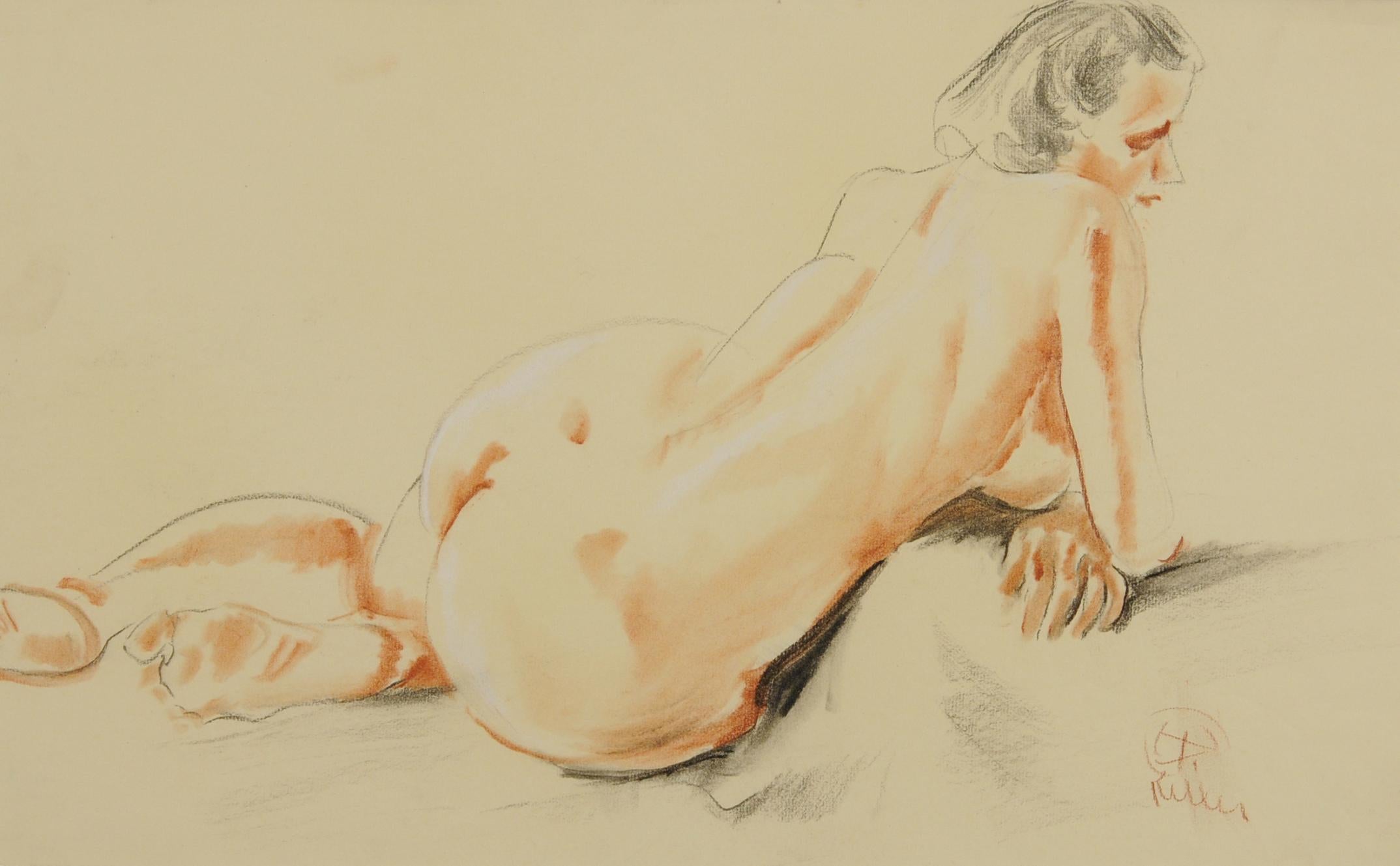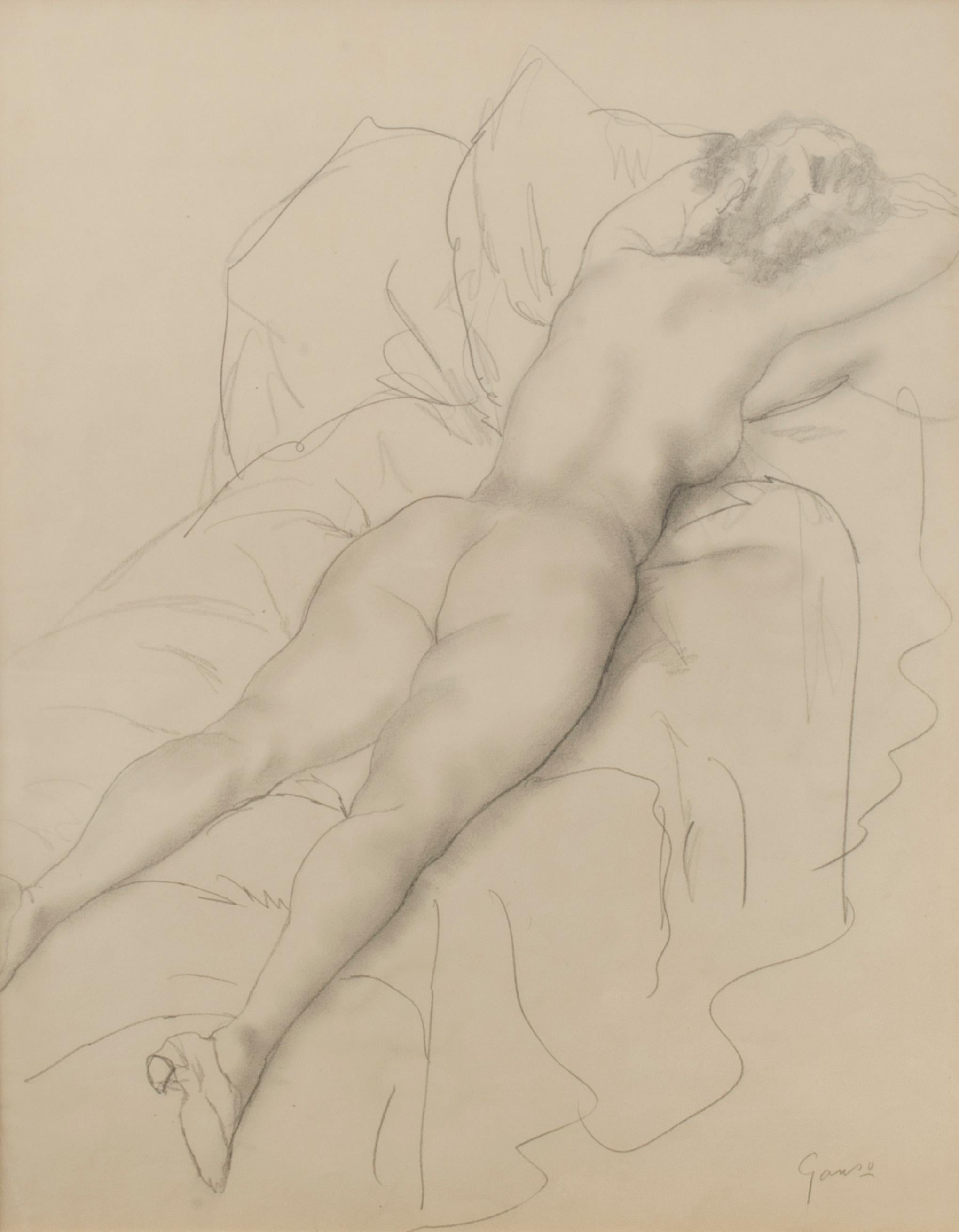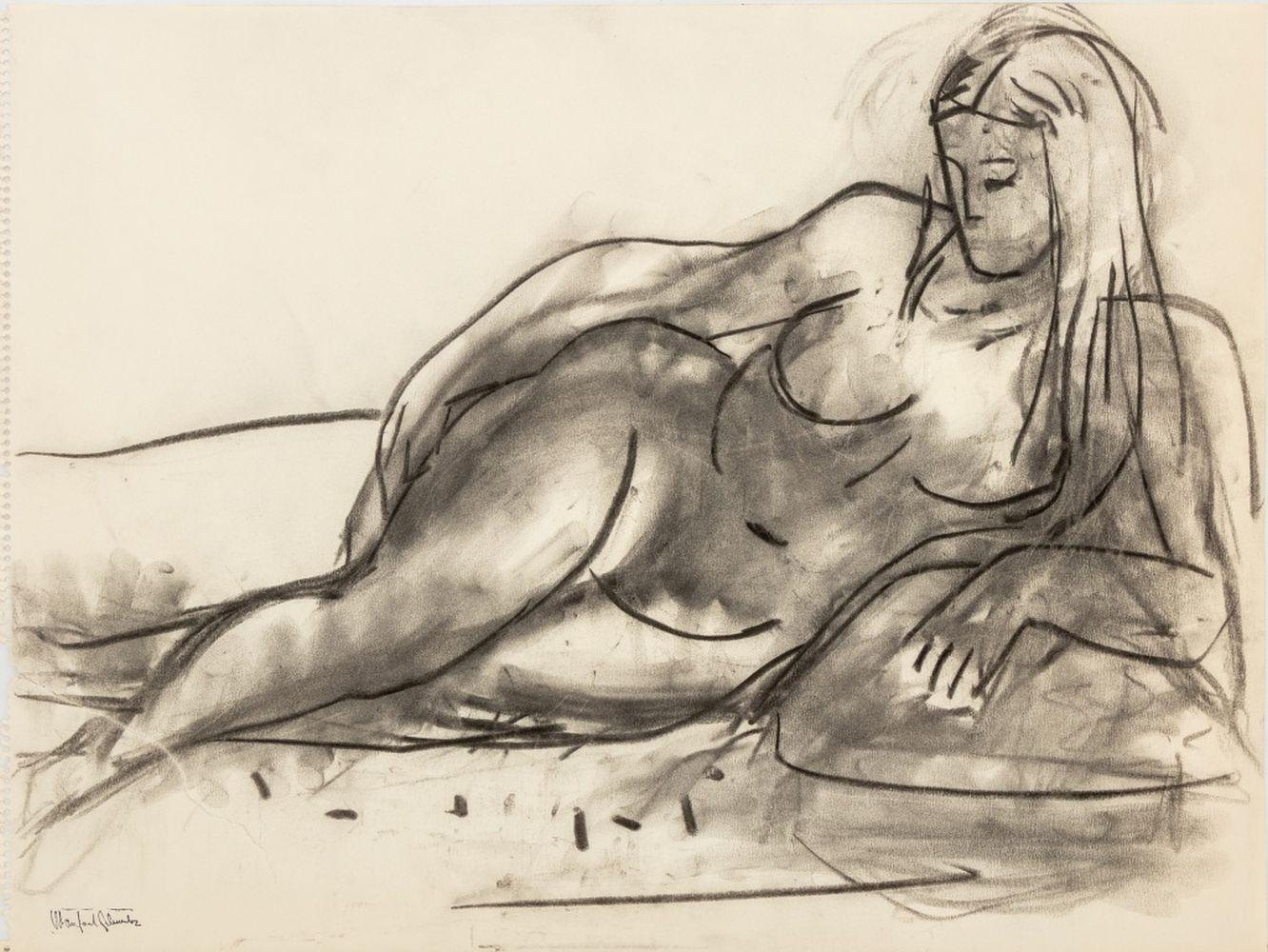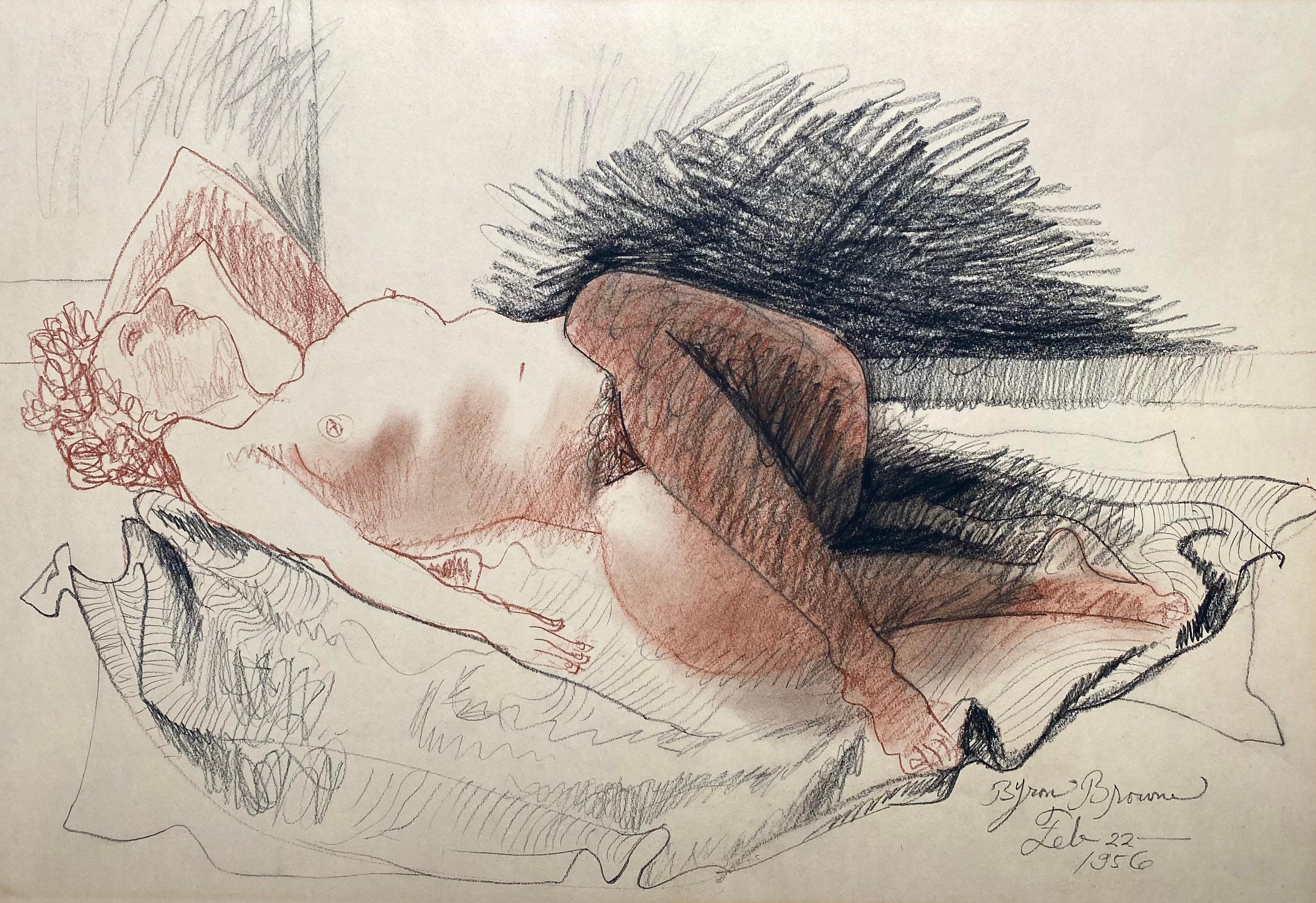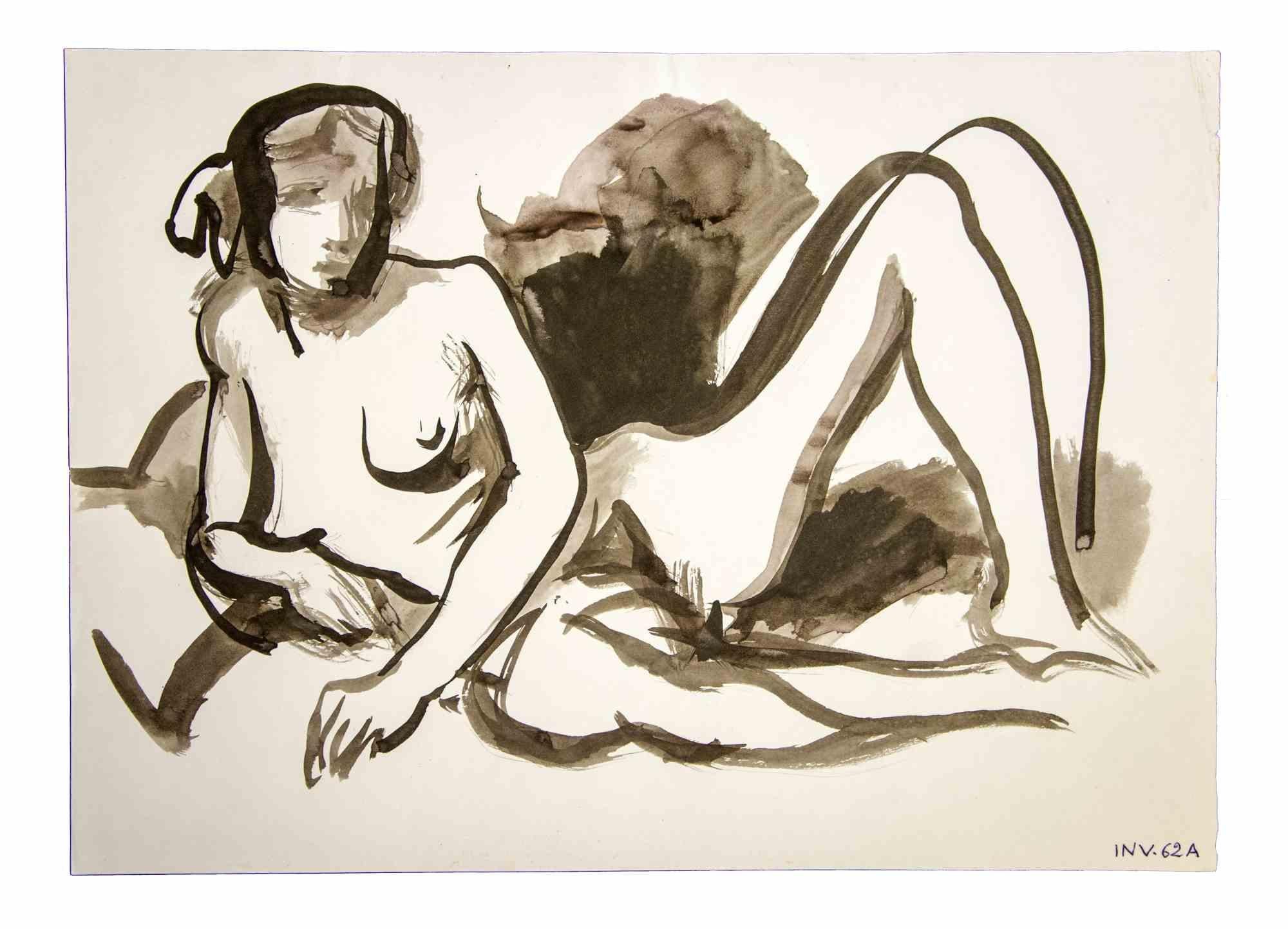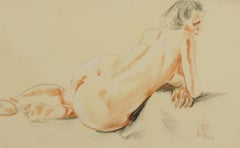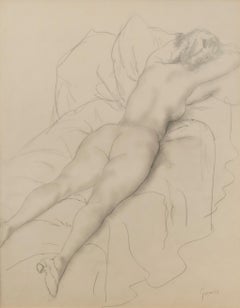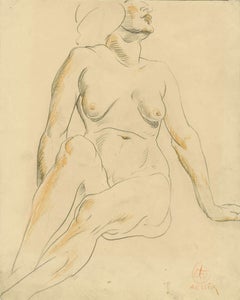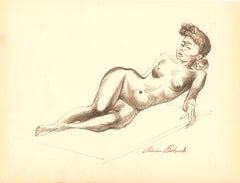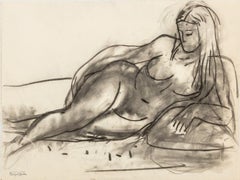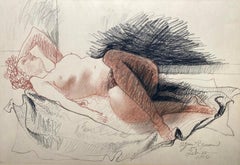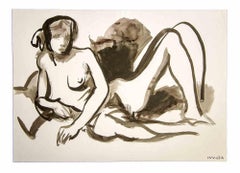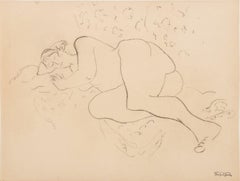Want more images or videos?
Request additional images or videos from the seller
1 of 9
Henry George KellerReclining Female Nudec. 1948
c. 1948
$950
£726.33
€836.58
CA$1,331.24
A$1,486.21
CHF 778.75
MX$18,192.62
NOK 9,890.13
SEK 9,325.13
DKK 6,243.49
About the Item
Reclining Female Nude
Charcoal and colored chalks with white highlights on tan laid paper, c. 1948
Signed and monogrammed by the artist lower right
(see photo)
A masterpiece drawing demonstrating the foreshortening of the model's legs.
From the Leona G. Prasse Collection, former Curator of Prints and Drawings at the Cleveland Museum of Art.
Condition: Excellent
Image size: 12 3/8 x 20 5/8 inches
Provenance: Leona E. Prasse (her collector's stamp n
reverse)
Lynn Prasse Bittel, her niece
THOMAS FRENCH FINE ART, LLC
Henry Keller
(1869-1949)
Born aboard ship off Nova Scotia of German parents on April 3, 1869. The Keller family settled in Ohio. Henry studied in Cleveland at the Institute of Art and for 43 years taught at that school. During the 1890s he worked there at the Morgan Lithograph Company, during which time he studied in NYC at the ASL. Keller made his first trip to California in 1915 to attend the PPIE. Following a visit to San Diego in 1925, he spent several summers there. He was elected an associate of the National Academy in 1939. In 1948 he moved to San Diego to live with his son and died there on Aug. 3, 1949. The subjects of his watercolors, oils, lithographs, and etchings include horses, figures, landscapes of Ohio, San Diego, and from his world travels. Exh: Royal Academy (Munich) 1902 (silver medal); Armory Show (NYC), 1913; Carnegie Inst., 1914-44; AIC, 1929 (prize); Calif. WC Society, 1940; Cleveland Museum, 1950 (memorial). In: Library of Congress; Whitney Museum (NYC); MM; Cleveland Museum; Boston Museum.
Courtesy: AskArt
Source:
Edan Hughes, "Artists in California, 1786-1940," American Art Annual 1903-33
American Magazine of Art, Sept. 1936
Who's Who in American Art 1936-47
KELLER, HENRY GEORGE (3 Apr. 1869-3 Aug. 1949), painter and teacher, was born at sea as his parents, Jacob and Barbara (Karcher) Keller, came to Cleveland. In 1887, Keller entered the Cleveland School of Art, studying for 3 years, then studying at Karlsruhe in Germany 2 years before returning to complete his Cleveland education. He studied in Dusseldorf, then at Munich from 1899-1902, and also attended the Art Students' League in New York and Cincinnati School of Art, working as a lithographer to finance his schooling. He joined the teaching staff at Cleveland School of Art (see CLEVELAND INSTITUTE OF ART), serving until 1945.
Keller had little sympathy with modernism, seeing his function as expressing nature as he saw it. In 1928, Keller won the Davis Purchase Prize at Witte Memorial Museum in San Antonio; in 1929, the Blair Purchase Prize at the Art Institute Internatl. Exhibition of Water Colors in Chicago. He made 11 Carnegie shows in Pittsburgh and had 1-man shows throughout the country. In 1919, he won the Special Award for sustained excellence for entries in the first MAY SHOW at the CLEVELAND MUSEUM OF ART. Keller's themes were American, and he felt the Midwest was the great reservoir of the American Idea. He started a summer school at Berlin Hts., Ohio, ca. 1908. Keller married Imogene Leslie on 2 Jan. 1893 and had 2 sons, Henry Leslie and Albert Fay. Following his wife's death in 1948, Keller moved to San Diego, Calif. Both Keller and his wife are buried in the old burying ground at Berlin Hts. Village.
Courtesy Case
THOMAS FRENCH FINE ART, LLC
Henry Keller
(1869-1949)
A native of Cleveland, Ohio, Henry Keller had a forty-year career as a teacher at the Cleveland School of Art and also directed a summer school at Berlin Heights, Ohio. He became the first artist in Ohio to achieve distinction in watercolor. By combining watercolor with tempera and other media, he created innovations widely adopted by his students including Charles Burchfield, Paul Travis, and Frank Wilcox. However, few remaining examples of his work have been found.
He was first trained at the Western Reserve School of Design for Women where he received special permission to attend classes. In 1890, he spent a year in Karlsruhe, Germany at the Art Academy and then returned to Cleveland to work as a circus poster designer for the Morgan Lithograph Company.
In 1899, he returned to Germany for further art studies and enrolled at academies in Dusseldorf and Munich. In 1902, he received a medal in a Munich Royal Academy exhibition and then returned to Cleveland to begin his teaching career.
Around 1903, he began painting outdoors at his family's farm near Berlin Heights, about 40 miles west of Cleveland, and since it was easily reached by train, other artists began to follow. By 1909, he had formally established his art school there.
He also collaborated with John MacCleod of Western Reserve University on a three-year scientific study of color theory. And 1913 he co-authored an article on "the physiology of color vision in modern art."
By 1913, he was the region's most outspoken advocate of avant-garde art and wrote the introductory essay for the catalogue of an exhibition of French Cubist paintings at the William Taylor Gallery in Cleveland in the summer of 1913. He lectured widely on the defense of European modernism, and two of his paintings were in the New York Armory Show.
Keller constantly traveled and often used watercolor to capture his impressions of Spain, Portugal, Puerto Rico, and the Austrian Tyrol. To capture the essence of each place he often worked quickly with spontaneous brushstrokes and pure color rather than the "literal descriptions of topography."
He was especially influenced by Paul Cezanne and Henri Matisse and developed a method of outlining his forms with intense blue to create a sense of volume. He also adopted Japanese methods of using decorative, rhythmic designs and the spirited brushwork in Chinese watercolor painting.
Courtesy: AskArt
Credits:
Robinson, W. "Henry Keller, Paintings of a Traveler." American Art Review, Winter 1994
- Creator:Henry George Keller (1870-1949, American)
- Creation Year:c. 1948
- Dimensions:Height: 12.38 in (31.45 cm)Width: 20.63 in (52.41 cm)
- Medium:
- Movement & Style:
- Period:
- Condition:
- Gallery Location:Fairlawn, OH
- Reference Number:Seller: FA78781stDibs: LU14016250362
About the Seller
5.0
Recognized Seller
These prestigious sellers are industry leaders and represent the highest echelon for item quality and design.
Gold Seller
Premium sellers maintaining a 4.3+ rating and 24-hour response times
Established in 1978
1stDibs seller since 2013
799 sales on 1stDibs
Typical response time: <1 hour
Associations
International Fine Print Dealers Association
- ShippingRetrieving quote...Shipping from: Akron, OH
- Return Policy
Authenticity Guarantee
In the unlikely event there’s an issue with an item’s authenticity, contact us within 1 year for a full refund. DetailsMoney-Back Guarantee
If your item is not as described, is damaged in transit, or does not arrive, contact us within 7 days for a full refund. Details24-Hour Cancellation
You have a 24-hour grace period in which to reconsider your purchase, with no questions asked.Vetted Professional Sellers
Our world-class sellers must adhere to strict standards for service and quality, maintaining the integrity of our listings.Price-Match Guarantee
If you find that a seller listed the same item for a lower price elsewhere, we’ll match it.Trusted Global Delivery
Our best-in-class carrier network provides specialized shipping options worldwide, including custom delivery.More From This Seller
View AllReclining Female Nude
By Henry George Keller
Located in Fairlawn, OH
Reclining Female Nude
Charcoal and colored chalks with white highlights on tan laid paper, c. 1948
Signed and monogrammed by the artist lower right
(see photo)
A masterpiece dr...
Category
1940s American Modern Nude Drawings and Watercolors
Materials
Chalk
Reclining Female Nude
By Emil Ganso
Located in Fairlawn, OH
Reclining Female Nude
Charcoal on paper, c. 1933
Signed lower right (see photo)
Provenance:
Weyhe Gallery, New York (Ganso's dealer 1925-1941)
Joseph Mark Erdelac, Cleveland, noted c...
Category
1930s American Modern Nude Drawings and Watercolors
Materials
Graphite
Untitled (seated female nude)
By Henry Keller
Located in Fairlawn, OH
Seated Femake Nude
Graphite and chalk on tan paper, c. 1920
Signed "Keller" and signed again with the artist's initials in a cypher
A finished life drawing most probably exhibited at...
Category
1920s American Modern Nude Drawings and Watercolors
Materials
Graphite
Nude Reclining on a Mat
By Aaron Bohrod
Located in Fairlawn, OH
Nude Reclining on a Mat
Ink on paper, n.d.
Signed in red ink lower right
Same model used in Elliott & Wooden pages 198 and 199
Condition: Excellent
Provenance: Estate of the Artist
Warren Shaull, Dodge City, KS (collector's stamp verso)
Aaron Bohrod (21 November 1907 – 3 April 1992) was an American artist best known for his trompe-l'œil still-life paintings.
Education
Bohrod was born in Chicago in 1907, the son of an emigree Bessarabian-Jewish grocer. Bohrod studied at the School of the Art Institute of Chicago and the Art Students League of New York between 1926 and 1930. While at the Art Students League, Bohrod was influenced by John Sloan and chose themes that involved his own surroundings.
Career
He returned to Chicago in 1930 where he painted views of the city and its working class. He eventually earned Guggenheim Fellowships which permitted him to travel throughout the country, painting and recording the American scene. His early work won him widespread praise as an important social realist and regional painter and printmaker and his work was marketed through Associated American Artists in New York. Bohrod completed three commissioned murals for the Treasury Departments Section of Fine Arts in Illinois; Vandalia in 1935, Galesburg in 1938 and Clinton in 1939. During World War II, Bohrod worked as an artist; first in the Pacific for the United States Army Corps of Engineers' Army War Art Unit...
Category
Mid-20th Century American Realist Nude Drawings and Watercolors
Materials
Ink
Reclining Female Nude Leaning on One Arm
By Paul Cadmus
Located in Fairlawn, OH
Reclining Female Nude Leaning on One Arm
Colored chalks on grey Strathmore paper. c. 1975
Signed in pencil upper left: Cadmus (see photo)
Provenance: Estate of the Artist
...
Category
1970s American Realist Nude Drawings and Watercolors
Materials
Chalk
Recling Female Nude, seen from the rear
By Emil Ganso
Located in Fairlawn, OH
Recling Female Nude, seen from the rear
Conte crayon on paper. c. 1936
Signed "Ganso" right (see photo)
Illustrated: Esquire Magazine, "Emil Ganso, Handy Artist", July 1938, pages 58...
Category
1930s American Modern Nude Drawings and Watercolors
Materials
Crayon
You May Also Like
Reclining Female Nude
By Manfred Schwartz
Located in Astoria, NY
Manfred Schwartz (American, b. Poland, 1909-1970), Reclining, Charcoal on Paper, with the artist's signature stamped lower left, unframed. 18" H x 24" W. Provenance: From a 35 East 7...
Category
Mid-20th Century Modern Nude Drawings and Watercolors
Materials
Paper, Charcoal
“Reclining Female Nude”
By Byron Browne
Located in Southampton, NY
Original oil pastel on archival paper by the well known American artist, Byron Browne. Signed lower right and dated 1956. Condition is excellent. Recently professionally rematted. Original frame in very good condition. Overall framed measurements are 23.75 by 31.75 inches. Provenance: A Long Island, New York estate.
Byron Browne: American (1907-1961)
Byron Browne was a leader of the American Avante Garde art movement in the 1930’s and 40’s along with Bolotowsky, Greene, Gorky, and de Kooning. These artists helped pave the way for America, New York in particular, to be seen as a center for art innovation after decades of France being the art center of the world. He had more than 70 solo exhibitions during his lifetime.
Browne's early artistic training was conventional, and little about his time at the National Academy of Design (1924-1928) suggested he would depart from the traditional methods in which he was being schooled. Several experiences are identified as being important to his transformation to an abstract artist. In 1927, he and his friend Arshille Gorky visited Albert Gallatin...
Category
1950s Modern Nude Drawings and Watercolors
Materials
Oil Pastel, Archival Paper
$960 Sale Price
20% Off
Reclined Nude - Drawing by Leo Guida - 1970s
By Leo Guida
Located in Roma, IT
Reclined Nude is an original drawing in watercolor on paper realized by Leo Guida in the 1970s.
Good condition.
Leo Guida (1992 - 2017). Sensitive to current issues, artistic movem...
Category
1970s Contemporary Nude Drawings and Watercolors
Materials
Watercolor
Reclining Female Nude
By Manfred Schwartz
Located in Astoria, NY
Manfred Schwartz (American, b. Poland, 1909-1970), Reclining Female Nude, Charcoal on Paper, woman resting upon patterned drapery, with the artist's signature stamped lower right, un...
Category
Mid-20th Century Modern Nude Drawings and Watercolors
Materials
Charcoal, Paper
Reclined Nude - Drawing by Leo Guida - 1980s
By Leo Guida
Located in Roma, IT
Reclined Nude is an original artwork realized in the 1980s by the Italian Contemporary artist Leo Guida (1992 - 2017).
Original drawings in Watercolor on paper.
Good conditions b...
Category
1970s Contemporary Figurative Drawings and Watercolors
Materials
Watercolor
Reclined Nude - Drawing by Leo Guida - 1970s
By Leo Guida
Located in Roma, IT
Reclined Nude is an original drawing in Ink and watercolor realized by Leo Guida in the 1970s.
Good condition.
Leo Guida (1992 - 2017). Sensitive to current issues, artistic movem...
Category
1970s Contemporary Nude Drawings and Watercolors
Materials
Ink, Watercolor
More Ways To Browse
Used Recliners
Nude Female Art Models
French Female Nude
French Nude Photo
German Paintings Nude
Modern Nude Photo
French Lithograph Nude
Female Nude French Painting
Nude Wife
Nude Native
Henry G
Paul Thomas
Old California Watercolors
Nude With Horse
German Female Nudes
Recliner 1950
Vintage Circus Drawings
Japanese Exhibition Poster
